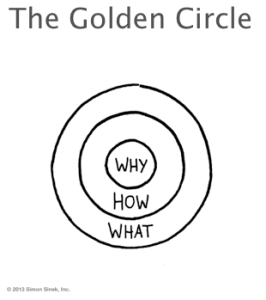Following on from Sir Ken Robinson on education and creativity, this next TED talk recommendation is about inspiration. It explains something that is so simple, and yet so powerful. A vital ingredient that is missing from many of the companies we work with, or work for, or buy products and services from. An idea that can galvanise action, or if it’s missing can make the message fall flat so that we say – meh!
This talk comes from the independently run TEDx talks rather than the main conference. It is from TEDxPugetSound which happened on 16 September 2009. The video was loaded to YouTube a few days later and to date it has 1,382,600 views. Simon Sinek explains that we should “Start With Why” because that is the way great leaders inspire action. It applies to marketing, business, politics – anywhere that you need to inspire action.
Simon’s talk doesn’t use fancy graphics. It’s low tech, using a flip chart and some coloured pens to draw diagrams, but he amplifies the message with some great stories and examples that we already know from history or our daily lives, but he shows us something different, something that should be obvious – like so many great ideas.
His examples include wondering why Apple is so innovative and loved, when they are just a computer company. He wonders why Martin Luther King led the civil rights movement in the United States in the 60s – many people were involved, but we focus on Dr. King – why is that? And he tells us the story of the Wright Brothers taking flight.
 The core of his idea is what he calls The Golden Circle. Every single organisation in existence knows what they do. Most of those organisations know how they do it. Very few know or express why they do what they do, and that’s Simon’s key point – so many companies have forgotten their why. It’s not about profit, and it shouldn’t be about shareholder value. Even the great Jack Welch, CEO of GE, said “on the face of it, shareholder value is the dumbest idea in the world”. Actually when people start companies it is based around a cause or a belief or an idea about doing things better. Simon’s first example is Apple, and he highlights the difference between those technology companies that just make products against Apple’s “why” which they had at the start and then lost, and then found again when Steve Jobs returned to the company. For everything they do they believe in challenging the status quo, and that drives them to make beautifully designed products that are easy to use and desirable. If you ever heard Steve Jobs speak, it was always about why, with much less emphasis on the what and the how. Simon suggests it’s too easy to start from the outside of the circle and work in. If you want to inspire people you start from the inside and work out.
The core of his idea is what he calls The Golden Circle. Every single organisation in existence knows what they do. Most of those organisations know how they do it. Very few know or express why they do what they do, and that’s Simon’s key point – so many companies have forgotten their why. It’s not about profit, and it shouldn’t be about shareholder value. Even the great Jack Welch, CEO of GE, said “on the face of it, shareholder value is the dumbest idea in the world”. Actually when people start companies it is based around a cause or a belief or an idea about doing things better. Simon’s first example is Apple, and he highlights the difference between those technology companies that just make products against Apple’s “why” which they had at the start and then lost, and then found again when Steve Jobs returned to the company. For everything they do they believe in challenging the status quo, and that drives them to make beautifully designed products that are easy to use and desirable. If you ever heard Steve Jobs speak, it was always about why, with much less emphasis on the what and the how. Simon suggests it’s too easy to start from the outside of the circle and work in. If you want to inspire people you start from the inside and work out.
He goes on to suggest that the golden circle mirrors the structure of the brain, with logic and language controlled by the neo cortex, but the limbic brain controls feelings of trust and loyalty – that’s where we make our gut decisions (which we then rationalise with the neo cortex part of the brain).
 He uses TiVo as an example of a great product which failed because the marketing and positioning never properly explained its “why”, and then moves on to the story explaining why the Wright Brothers were the first to take flight. His final example goes back to the Civil Rights movement in the US and Martin Luther King’s speech at the Lincoln Memorial in Washington DC. It was delivered to 250,000 supporters – there were no formal invites, no websites to tell people where to go and when – it was word of mouth and the power of Dr. King’s message that brought the huge audience. Importantly, Simon Sinek quips:
He uses TiVo as an example of a great product which failed because the marketing and positioning never properly explained its “why”, and then moves on to the story explaining why the Wright Brothers were the first to take flight. His final example goes back to the Civil Rights movement in the US and Martin Luther King’s speech at the Lincoln Memorial in Washington DC. It was delivered to 250,000 supporters – there were no formal invites, no websites to tell people where to go and when – it was word of mouth and the power of Dr. King’s message that brought the huge audience. Importantly, Simon Sinek quips:
“by the way, he gave the I Have a Dream speech, not the I Have a Plan speech!”
Simon tells us there are leaders and there are those who lead. Leadership is not about power and authority – those who lead inspire us. Simon’s message can help you do the same. Watch the TED talk and then go to his website for useful (free) resources. You could also read the book.
If you want to understand more of our Agile Elpehant thinking, check the rest of our blog material and take a look at the Enterprise Digital Summit London in October. We’d love to hear your comments or suggestions or to see you in London next month.
